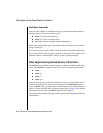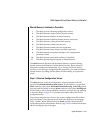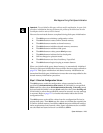
2-8 IBM Informix OnLine Database Server Administrator’s Guide
Initialization Commands
Shared-memory initialization establishes the contents of shared memory
(OnLine internal tables and buffers) according to the parameter values
contained in the configuration file. The tbinit process reads the configuration
file and detects and implements any changes in the size or location of any
OnLine shared-memory structure since the last initialization. A record of the
changes is written to the OnLine message log as well.
Two key differences distinguish shared-memory initialization from disk-
space initialization:
■ Shared-memory initialization has no effect on disk space allocation
or layout; no data is destroyed.
■ Fast recovery is performed as part of shared-memory initialization.
(Refer to page 4-39 for a description of fast recovery.)
Disk-space initialization uses the values stored in the configuration file to
create the initial chunk of the root dbspace on disk and to initialize shared
memory. When you initialize disk space, shared memory is automatically
initialized for you as part of the process.
When you initialize OnLine disk space, you overwrite whatever is on that
disk space. If you reinitialize disk space for an existing OnLine system, all
data in the earlier OnLine system becomes inaccessible and, in effect, is
destroyed.
The tbinit process is the first OnLine process executed by an administrator.
During initialization, the tbinit process forks and spawns a tbinit child
process, which is the tbinit daemon. The tbinit daemon process does most of
the initialization work and, after initialization is complete, serves as the
master OnLine daemon.
Initialization Commands
Only user informix or root can execute tbinit and initialize OnLine. OnLine
must be in offline mode when you begin initialization.
You execute the tbinit process by entering the command tbinit (with or
without command-line options) at the UNIX prompt or by requesting initial-
ization through DB-Monitor.


















